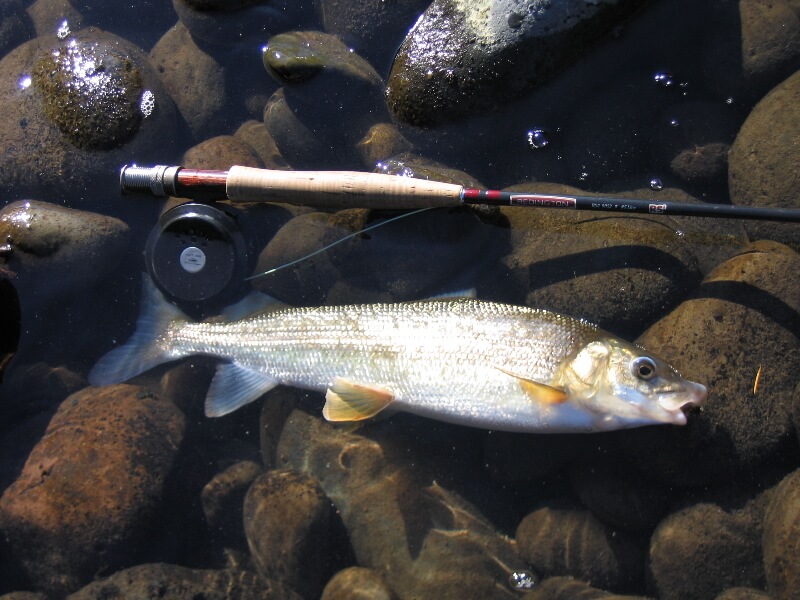What’s Wrong with Whitefish?
by Nate Bradley
Broadcast 12.10 & 12.15.2017

Listen:
I dipped my woven landing net into the frigid creek water and drew the fish towards my legs. It was winter and I was standing mid-calf deep in a favorite fishing spot outside Missoula. I knew the fish wasn’t a trout before I scooped it into my net.
An icy bank embraced the creek, and my breath rose before me, rhythmically billowing out my mouth and nostrils. The fish nonchalantly took one of the nymphs I had been sinking near the creek bottom, diving into the depths and pulling its weight into my fly line. I could feel its tail in the handle of my fly-rod, palpitating like an irregular heartbeat.
In the water, the fish was gray-green along its back and dorsal fin with a speckling of silver flashes as the scales caught the weak sunlight. Its wide forked tail had the characteristic grey-blue color. I lifted the fish from the water and removed the fly from its small, toothless mouth.
“Is that a whitefish?” my buddy called from upstream. “You know they don’t count.”
But why shouldn’t they count? Mountain whitefish average about 12 inches long and are one of the most prolific native fish in the West, living in mountain streams and lakes from Alaska and western Canada to parts of Nevada, California, and Utah
Whitefish are active year-round, feeding mostly at dusk and just after dark. During the late fall spawning season whitefish gather in large schools where each female releases about 4,000 eggs over rocky riffles in streams for males to fertilize. The eggs have adhesive properties which glue them to the river bottom for six to 10 weeks where the egg matures before hatching in the spring. These newborn fry must mature for three years before reproducing.
Whitefish are native fish which evolved alongside prized Montana species like bull trout, cutthroats, and grayling. Although their appearance is different, whitefish are related to these other species and included in the same family, Salmonidae.
Yet a lot of fly fishers consider them a nuisance. Part of the negative stigma comes from the mistaken belief that whitefish compete with trout for food and habitat. But, this is not true. Whitefish have small mouths designed to suck aquatic insects and larvae from river bottoms, while trout mostly feed in the middle and upper sections of the water. Although whitefish will occasionally eat surface insects, there is little competition.
While trout are the claim to fame of most Montana fisheries, mountain whitefish outnumber them 10 to 1 in iconic Montana rivers like the Yellowstone, Kootenai, and Flathead. Most people who fish in Montana, float a river, or just take the time to peer into pools and ripples have the opportunity to admire this underappreciated Montana native.
I chuckled at my friend’s comment. Crouched over the water, I held the 15-inch whitefish in my numbing fingers, then slipped it gently into the creek. It swam away, deliberate and calm, fading into the creek bottom — where it belongs.
Every week since 1991, Field Notes has inquired about Montana’s natural history. Field Notes are written by naturalists, students, and listeners about the puzzle-tree bark, eagle talons, woolly aphids, and giant puffballs of Western, Central and Southwestern Montana and aired weekly on Montana Public Radio.
Click here to read and listen to more Field Notes. Field Notes is available as a podcast! Subscribe on iTunes, Google Play, or wherever you listen to podcasts.
Interested in writing a Field Note? Contact Allison De Jong, Field Notes editor, at adejong [at] montananaturalist [dot] org or 406.327.0405.
Want to learn more about our programs as well as fun natural history facts and seasonal phenology? Sign up for our e-newsletter! You can also become a member and get discounts on our programs as well as free reciprocal admission to 300+ science centers in North America!












